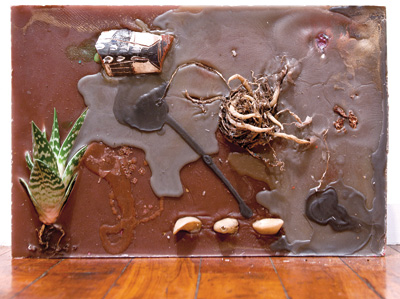
Like many of us, Heidi Norton doesn't start out with the intention of killing her houseplants. On occasion, however, the death of a spider plant or an Areca Palm is the unavoidable result of her art-making practice. Norton's sculptures are a lot like gardens: they need a certain amount of tending, and there's a good chance that what starts out green and lush will end up brown and withered. In a piece recently exhibited at San Francisco's HungryMan Gallery, the resin-slathered leaves of a banana plant, root ball intact, were affixed to a sheet of Plexiglas propped up on two white plinths. Another work featured a pink-leaved Cherry Sensation palm and two smaller plants flattened like pressed flowers against an angled Plexiglas square, a watering can resting pointedly nearby. In the front windows were two sculptures that looked like luminous slabs of crystal but were in fact chunky bricks of colored wax embedded with short-rooted plant slips.
During a recent visit to the artist's large, light-filled studio in the Garfield Park area of Chicago, Norton--until recently, best known as a photographer--tells me that she started using plants as a way to introduce a sense of fluctuation into an otherwise static still life tradition. For her New Age Still Life photographs (2009-present), Norton arranged potted house plants, sometimes painting their leaves white or black to match the photographs' backdrops, on shelves alongside seashells, books, mirror shards and glass jars filled with sedimentary layers of colored sand--objects chosen not just for their formal qualities but for the personal memories they evoke. Norton's upbringing in a rural area of West Virginia was decidedly unconventional; she and her sister were the children of hippie parents who embraced an alternative style of rural homesteading--they were living off the grid before the term even existed.
Norton's studio looks like a three-dimensional version of her photographs. An array of indoor plants rest on wooden shelves affixed to a South-facing bank of windows. On the floor lies a large wax sculpture that Norton worries will be too heavy to lift and display at her upcoming exhibition at Chicago's Ebersmoore Gallery (and in fact, the piece does break a few weeks later). She laughingly compares her workspace to a laboratory, or a nursery. "When I'm in my studio, I can disconnect from the outside world," she explains. "Things are always in flux... it's kind of magical." Norton refers to Joseph Beuys, himself known for working with organic materials, to clarify aspects of her own process. "Beuys' idea is that the sculpture is never fixed or finished. He talks about it in terms of chemical reactions and flux," Norton explains. "I'm trying to embrace that idea of flux and decay. I'm also interested in how the sculpture changes--like in color, the leaves turning from bright green to yellow or pink to brown" over time.
Which leads to the question Norton invariably is asked--are the plants meant to survive once they become works of art? "I do want the plants to be nurtured, and part of that involves watering them and tending to them," she says. That implicit ethical obligation between the collector or caretaker and the work of art is in Norton's sculptures rendered explicit: "Are you going to take care of it?" she asks of hypothetical future owners. "It's in your hands, and now you have an investment in it too." It may seem like a burden, but Norton thinks it can also be satisfying--and fun. "I like that [the plants] take sculpture off of its 'high art' pedestal," she notes. "It's okay to get your hands dirty and fuss around with it and touch it. The connection is more personal."
Heidi Norton: "Not to See the Sun" is currently on view at Ebersmoore, in Chicago, from April 8 - May 14, 2011. www.ebersmoore.com
Heidi Norton: "Between New Moons" was on view at Hungryman Gallery in San Francisco, from February 12 - March 20, 2011. www.hungrymangallery.com
This article was written for and published in art ltd. magazine ![]()
